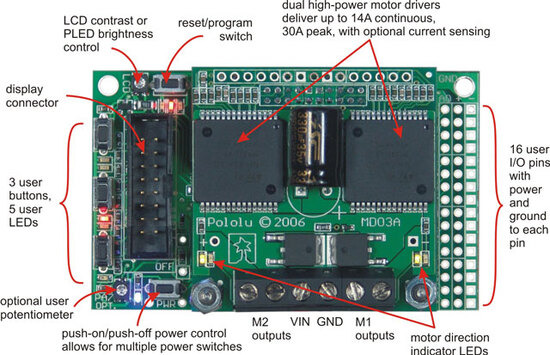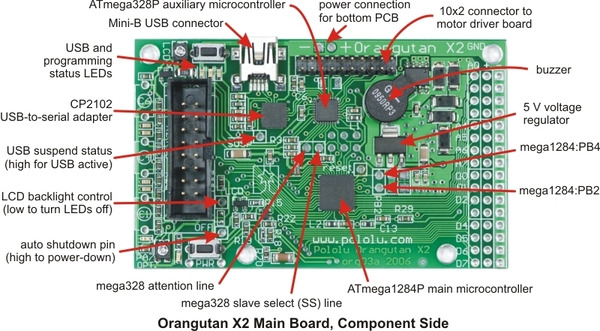This robot controller is by far the most powerful Orangutan, and it is intended for small and medium-sized robots.
Note: As of October 25, 2010, all Orangutan X2 versions are shipping with programmable ATmega1284P microcontrollers instead of the ATmega644P included on older units. The ATmega1284P has 128 KB of program memory, 16 KB of RAM, and 4 KB of EEPROM, and it offers an additional 16-bit timer (TIMER3).
The Orangutan X2, the most powerful member of Pololu’s line of Orangutan robot controllers, is designed to be a compact, high-performance control centre for robotics and automation projects. The Orangutan X2’s two-board design allows the unit to maintain the compactness characteristic of the Orangutan line while offering substantially more electrical and computational power: the X2 can deliver up to a horsepower across two motor channels, and the twin-microcontroller architecture allows maximum access to the primary microcontroller, an Atmel ATmega1284P AVR running at 20 MHz with 128 KB of program memory and 16 KB of SRAM. It has an outline smaller than a credit card, which makes it small enough to fit in a mini-sumo or small maze solver, yet it is powerful enough to run a 1/10th-scale monster truck. The board features an integrated dual motor driver capable of delivering 14 A continuous (30 A peak) per channel, a buzzer for simple sounds and music, an LCD port with optional 20×4 character LCD, three user pushbuttons, five user LEDs, a built-in programmer and USB connectivity, and more; a battery, motors, and sensors can be connected directly to the module for quick creation of advanced, powerful robots.
 |
| Pololu Orangutan X2 Robot Controller, top view with top and bottom board and labels (power capacitor orientation may vary). |
|---|
Note: The motor driver (top) board pictured above is also available separately as a dual high-power motor driver.
The Orangutan X2 has two microcontrollers: a user-programmable Atmel ATmega1284P AVR for the main application, and an auxiliary ATmega328P that is pre-programmed to interface with most of the dedicated hardware on the X2 and serve as an AVR ISP programmer for the main processor, which means that no external programmer is required. The two-microcontroller design simplifies multitasking by relieving the main processor of common tasks such as motor control and melody generation, and the approach also leaves almost all of the mega1284 hardware peripherals, such as timers and interrupts, and most of the mega1284 I/O lines to be used for your higher-level design.
The Orangutan X2 is compatible with freely available development software for Atmel’s AVR microcontrollers, including Atmel’s AVR/Atmel Studio, the WinAVR GCC C/C++ compiler, and AVRDUDE. We provide an extensive set of software libraries that make it easy to interface with all of the integrated hardware, including the auxiliary microcontroller. Using these libraries, it takes just a few simple lines of code to write to the LCD, read button presses, drive motors, and control servos. These libraries come with a number of sample programs that demonstrate how to use the various components on the Orangutan X2.
 |
|
|
|
The most basic unit (VNH3SP30 motor drivers, no LCD) is $109. Upgrading to VNH2SP30 motor drivers adds $10 to the basic unit cost, and adding an LCD adds $30. The highest-end Orangutan X2 (VNH2 motor drivers with LCD), is $149. For more information about the VNH motor drivers, please see the “VNH3SP30 and VNH2SP30 Comparison” section of the dual high-power motor driver page.
To get started programming your Orangutan X2, please see the Pololu AVR Programming Quick Start Guide.
Please see the resources tab for the Orangutan X2 quick-start sheet, further documentation, and related links.
| Size: | 3.00" x 1.86" |
|---|
| Processor: | ATmega1284P with slave ATmega328P @ 20 MHz1 |
|---|---|
| RAM size: | 16384 bytes |
| Program memory size: | 128 Kbytes |
| Motor driver: | VNH3SP30 |
| Motor channels: | 2 |
| User I/O lines: | 182 |
| Max current on a single I/O: | 40 mA |
| Minimum operating voltage: | 6 V |
| Maximum operating voltage: | 16 V |
| Continuous output current per channel: | 9 A |
| Peak output current per channel: | 30 A |
| Continuous paralleled output current: | 15 A |
| Maximum PWM frequency: | 9.77 kHz |
| Reverse voltage protection?: | Y3 |
| External programmer required?: | N |
| LCD included?: | Y |
 Pololu AVR C/C++ Library User’s Guide (Printable PDF)
Pololu AVR C/C++ Library User’s Guide (Printable PDF)
Information about installing and using the C/C++ libraries provided for use with Pololu products.
 CP2102 USB-to-Serial Bridge Driver Installation (Printable PDF)
CP2102 USB-to-Serial Bridge Driver Installation (Printable PDF)
CP2102 Drivers and installation instructions for Windows, Mac, and Linux. The CP2102 is used on the Pololu USB-to-Serial Adaptor, the Orangutan USB Programmer, the USB 16-Servo Controller, and the Orangutan X2.
 Pololu AVR Library Command Reference (Printable PDF)
Pololu AVR Library Command Reference (Printable PDF)
A reference to commands provided in the Pololu C/C++ and Arduino libraries for the AVR.
 Orangutan X2 Command Documentation v1.01 (Printable PDF)
Orangutan X2 Command Documentation v1.01 (Printable PDF)
Documentation of the low-level SPI commands used to control the Orangutan X2’s auxiliary ATmega328 microcontroller. These commands are implemented by the Pololu AVR Library, so beginners do not need to concern themselves with the details in this document.
Guide for programming Orangutans and the 3pi robot from the Atmel’s older AVR Studio 4 IDE. It covers installing the Pololu AVR C/C++ Library, and setting up the Pololu USB AVR Programmer.